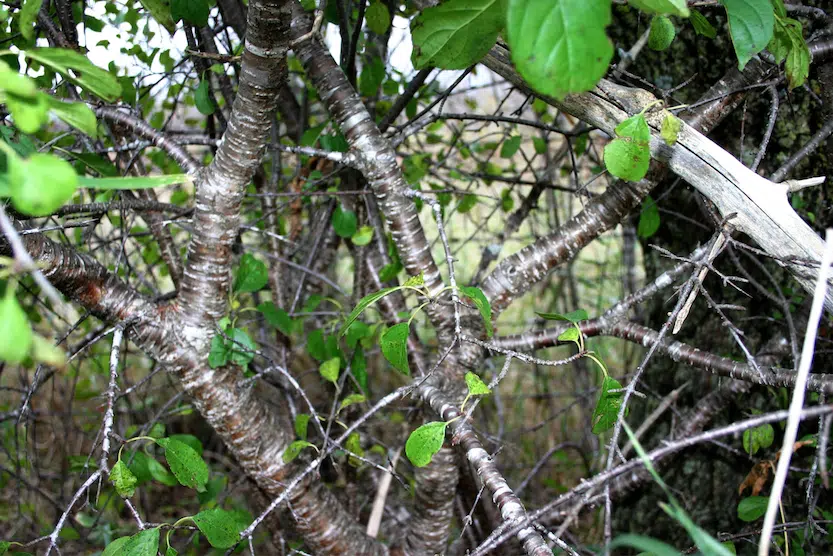Table of Contents
If you’re reading this article, chances are good that you’ve discovered buckthorn on your property. Ok, so you’ve identified a problem but what’s the solution? This article will suggest 7 ways to effectively remove buckthorn. But before we look at methods for getting rid of buckthorn, we should first consider where it came from, what it looks like, how it spreads, and why it’s a problem.
Origin of Buckthorn
In the late 1800’s buckthorn was imported from Europe. It was intended to be used as a hedgerow species because of its durability. While this goal was indeed accomplished, the buckthorn created a new problem because it began to spread uncontrollably to natural areas like forest preserves and prairies. Fast forward 150 years, buckthorn is now classified as a noxious weed in various northern states. Moreover, importing or transplanting buckthorn is considered illegal.
Buckthorn Identification
There are two main types of buckthorn: common and glossy. Buckthorn is a tall shrub that can turn into a mid-sized tree, growing up to 20 feet tall. It has brown bark with elongated silvery, corky projections. Its twigs have small, sharp thorns on the end. If you cut a branch it will show yellow sapwood and orange heartwood. Buckthorn leaves have a serrated edge and stay green until late fall. The leaf shape is roughly oval and has an indented mid-vein that goes through the center from top to bottom. Each leaf will have 4-5 upward curving veins on each side of the mid-vein. Buckthorns have an extensive fiber-like root structure.
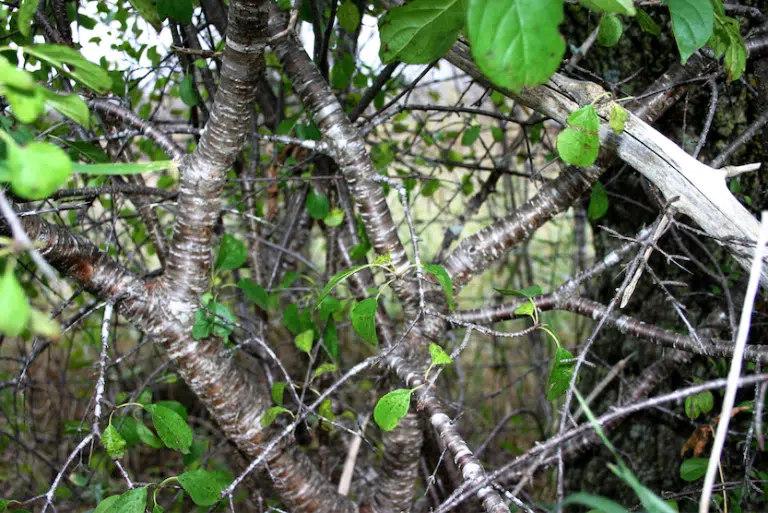
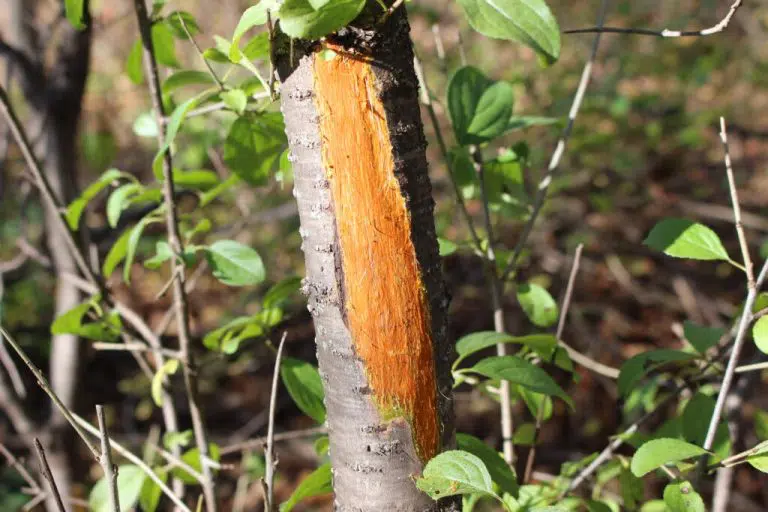
Berries on Buckthorn
Toward the end of summer, mature female buckthorns produce clusters of berries. The color of the berries is blackish purple. Each berry is home to 4-5 seeds that can survive in the soil for 3-4 years from the point of fertilization. The stem of each individual berry connects right onto the twig. Buckthorn trees can generate upward to several hundred berries each season. The berries are connected to the small branches of common buckthorn. Berries are responsible for the rapid spreading. Why? The main reason is because dark berries are attractive to animals who distribute the seeds, which causes new buckthorn seedlings to germinate. The ironic part is that these berries have a laxative effect that actually prohibits nutrient absorption for birds and other animals. So they end up spitting them out which spreads the seeds at a rapid pace across landscape territory.

Buckthorn Problem
Buckthorn doesn’t have natural controls such as insects or disease that would reduce the intensity of its growth. It outcompetes native plants for moisture, light and nutrients. This creates a toxic environment for natural growth of the non-invasive species you actually want to thrive. It hinders the flourishing wildlife that should occur in forestry areas. Because of this, it endangers natural habitats such as prairies and wetlands. Buckthorn promptly colonizes any available woodland space and claims exclusive ownership of the territory. Any native vegetation “intruders” will be choked out and smothered by the dominance of the invasive species known as buckthorn. The result is no biodiversity of plant life. Other wildlife such as birds, animals and insects that rely on natural vegetation for shelter and food are also forbidden from living alongside buckthorn.

Invasion of Buckthorn
It all starts when one or two individual buckthorn seedlings germinate toward the edge of a woodsy property. Then berries from that season’s harvest ripen and get distributed to other open areas of the woods. Within a year or two, the saplings mature into big sized trees that also grow seeds that lead to more and more new buckthorn. This process continues on and on until buckthorn infests the entire woodland or until action is taken to eradicate it.
7 Ways to Effectively Remove Buckthorn
Now that we’ve learned about the origins of buckthorn, how to spot it, their spread via berries, and its invasive character, we can transition to various methods for eradication. That’s right, you don’t need to throw your hands in the air and say, “Well, this buckthorn is here to stay. Nothing I can do about it.” No, that’s actually not true. It is possible to restore your prairie, forest or woods back to its original buckthorn free condition. In my years of experience, I’ve discovered 7 methods that successfully get rid of buckthorn.
1. Use your hands
This approach is best when the buckthorn is small (1/2 inch diameter) and the number of buckthorns are few. Why? If the individual buckthorn circumference is too wide then you might tweak your back while attempting to pull it out. If there are too many buckthorn then you may get overwhelmed at the task to pull each one out individually. How do you pull them out by hand? Simply grab hold of the buckthorn with both hands close to the trunk and pull hard until the root system is fully dislodged. You’ll want to wear heavy duty gloves for this because, as noted earlier, buckthorn is very prickly.
2. Use a shovel
So long as the buckthorn is between 1-2 inches in diameter, you should be able to dig them out with a spade shovel. Since the root system is not excessively wide, this actually isn’t as hard as one might think. Stick your shovel point into the ground about 2 inches away from the trunk. Then use your dominant foot to step on the shovel edge so you can leverage the weight of your body to dig into the soil. Once you’ve done this, push down the shovel handle so the dirt and root system comes up along with the shovel head. After removal, you can shake off the dirt from the roots and use it to fill the hole back up.
3. Use a goat
Believe it or not, this is actually a thing! A herd of goats can be dispatched to graze on the buckthorn. Multiple sessions can lead to substantial reductions of buckthorn and other noxious plants. There are several benefits to this approach. It’s 100% eco-friendly so no chemicals are involved. Goats fertilize the ground during grazing as they leave their droppings. Mosquito and wood tick reductions occur as goats consume the buckthorn since the habitat changes. Unlike other animals, the stomach of goats is durable enough to eat noxious weeds without getting sick. Click here or here to learn more about the value of using goats for buckthorn removal.

4. Use a lopper
A lopper, also called a clipper or branch cutter, is a hand-held device that allows you to cut through buckthorn stumps up to 2 inches in diameter. Their bypass-style steel blade contributes to smooth cutting and low friction. To make the cut, just align the blade toward the bottom of the buckthorn stump and completely open the loppers in order to get the branch deep into the blade. Then close the loppers through the trunk in one quick motion. Remember to keep a tight grip on the handles, so you don’t let the loppers twist when you’re making the cut, otherwise the cut won’t be clean.
5. Use a weed wrench
There are two main weed wrench options: Pullerbear and Root Talen. The Root Talen can remove buckthorn up to 1 inch in diameter. It works by pushing the buckthorn away from your body. The Pullerbear can remove buckthorn up to 3 inches in diameter. It works by pulling the buckthorn toward your body. There are two reasons why Pullerbear is the clear winner here. First, it can remove larger buckthorn so it’s 3 times more useful. Second, it’s easier to use because pushing away from you is harder than pulling toward you.
6. Use a pruning saw
If the buckthorn happens to be too big for your lopper or weed wrench, then the next best option is to use a pruning saw. This device can comfortably cut through branches 3-4 inches in diameter. You should try to find a saw with a curved blade design because this maximizes the cutting performance. Avoid using a bow saw or a hand saw if possible since those aren’t designed for large branches.
7. Use a chainsaw
When buckthorn has matured to full size (4-6 inches in diameter), using a chainsaw will be the only way you can get rid of it. A chainsaw is a portable power tool that slices through wood with a fast-moving chain that rotates around a guide bar. This is the most dangerous power tool so be sure to follow all the chainsaw safety guidelines, including wearing gloves and a helmet with face guard. Don’t wear loose clothing since that’ll increase the risk of getting it caught in the teeth of the chainsaw.
Now that we’ve explored 7 ways to remove buckthorn, we should consider when’s the right time to treat it, how to apply herbicide or a non-chemical alternative, and what to do with the brush piles. Then we will conclude with some bonus content on how much money landscape companies charge to eradicate buckthorn.
The Best Time to Treat Buckthorn
Late summer or anytime in the fall tend to provide the best conditions for cutting buckthorn and treating the stumps. It’s easier to find invasive shrubs during the fall season because their leaves stay green a lot longer than other trees. Try to avoid treating buckthorn in May or June as those months are when the tree is putting out leaves. During the winter months buckthorn is transferring nutrients down to its root system in order to prepare for winter. If cut buckthorn stumps are not treated, they will re-sprout with more intensity and will become even harder to kill. The stumps should be treated immediately because the surface will seal up within a few minutes of being cut. Click here to read more.
2 Treatment Methods: Chemicals vs. Organic
You’ve learned when to treat buckthorn but now let’s turn our attention to the how question. There are two common methods for how to treat buckthorn stumps. One involves chemicals and the other is an organic-based alternative. Let’s unpack the chemical option first.
1. Herbicide Application on Buckthorn Stumps
After cutting the buckthorn, you’ll need to immediately apply a water-soluble product like RoundUp. It should contain at least 20% of glyphosate for maximum efficiency. The herbicide should be applied onto the stump within a few seconds so the chemicals can soak into the root system and prevent resprouting. These chemicals can be applied with a paint brush, a wick applicator such as a buckthorn blaster, a dauber, or a sprayer. Follow the instructions on the container label and wear protective gear like gloves and glasses. Avoid contact with your skin. Avoid overuse of chemicals as this will contaminate the soil and potentially damage surrounding plants.
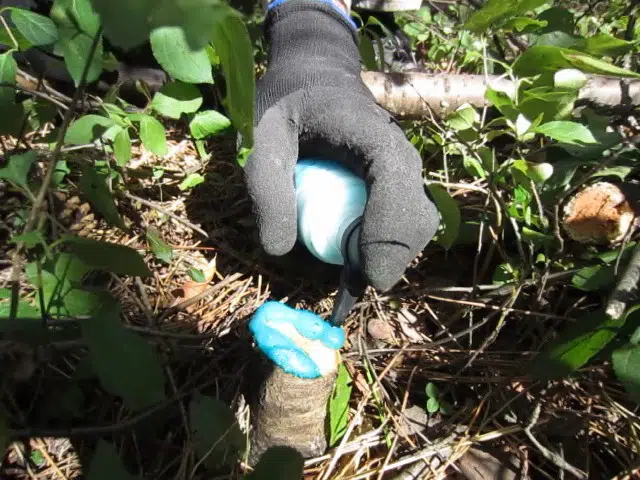
2. Suffocate Buckthorn with Small Bags
But what if you care deeply about the environment and don’t want to pollute the soil with toxic chemicals? As with most things, there is an organic way to do it! Stumps can be covered with a black plastic bag to suffocate the stem so it doesn’t grow back. However, it will take 1-2 years for the stump to fully die, so patience is required. Buckthorn Baggie is the company that pioneered this eco-friendly approach. So how does it work? Well, it’s actually pretty simple. Just place the plastic bag over the stump and zip tie the bag toward the middle of the stump. Ensure the bag is touching the ground.
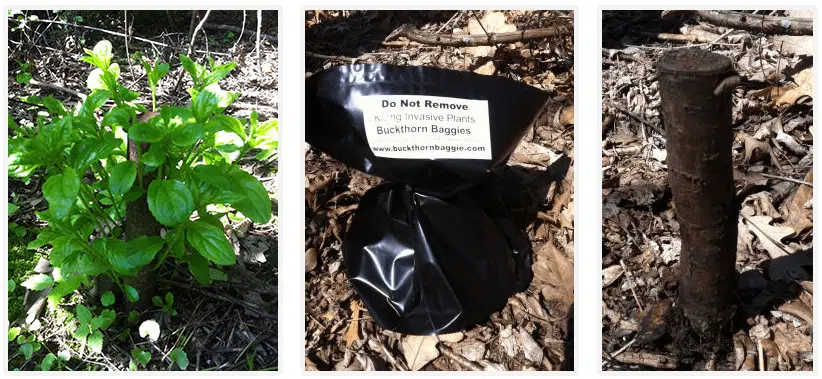
3 Ways to Dispose of Brush Piles
After you’ve successfully followed all these steps, your buckthorn will be removed from the ground but you’ll still be left with a massive pile of brush. What on earth are you gonna do to get rid of this buckthorn pile? Buckthorn is not biodegradable material so leaving the brush piles unattended won’t lead to compost. Here are 3 things you can do with the leftover pile, ordered from least expensive to most expensive.
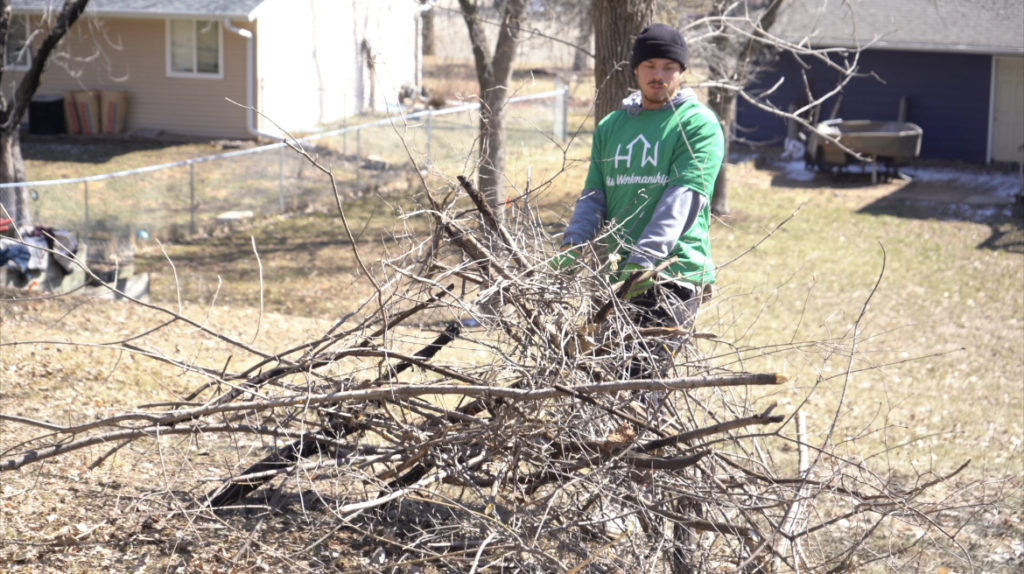
1. Burn in a fire pit
It is permissible to burn brush on private property but it must be a controlled fire in accordance with city guidelines. You may need to pull a permit depending on county regulation. If you have a firepit that is a legal distance away from your home, then that would be a good place to burn a very small brush pile. If you have over 2 cubic yards of brush, then it’ll take too long to cut the branches down to the appropriate size to fit in the firepit. If that’s the case, then you’ll want to consider one of the two options listed below.
2. Haul to a yard waste site
If you have a medium-size brush pile (3-5 cubic yards), then your best bet is to use a truck or trailer to dispose of them at your local yard waste site. If you don’t own a truck or trailer, then you can ask a neighbor or friend if you can borrow them. Otherwise, you can rent one from a local store. A pickup truck is best for 1-2 cubic yards, a utility trailer (pictured below) is ideal for 2-3 yards, and a dump trailer is optimal for 3-4 cubic yards. Be sure to use cinch straps to securely tie down the brush so it doesn’t fly off during the drive. Best practice is to tie brush down in a criss-cross pattern.
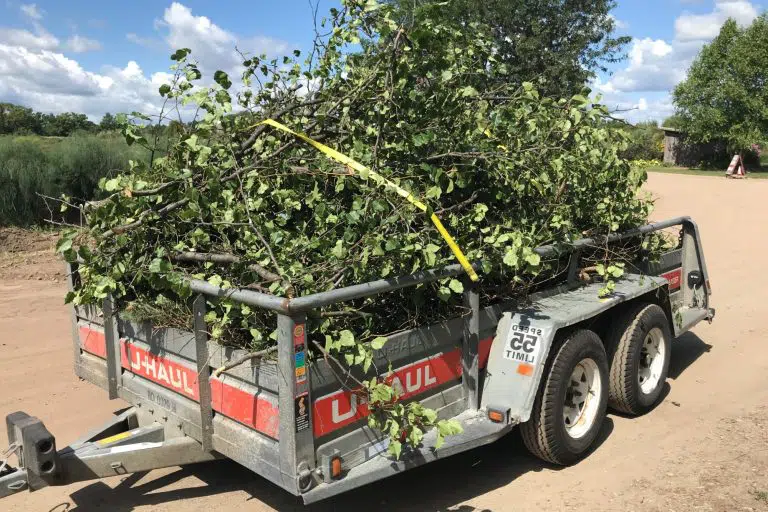
3. Mulch with a wood chipper
For large amounts of brush (4+ cubic yards) it’ll be worth the extra cost to rent a wood chipper. Operating a wood chipper is pretty self-explanatory. Once on site and powered up, simply grab the buckthorn stems and glide them into the wood chipper one at a time. When feeding the chipper, start with the blunt end first as this will be easier on the machine. Even though this is the most expensive option, it sure beats making multiple trips to the yard waste site. Plus, you can use the chipped up brush as mulch for your garden beds. Don’t worry, chipped up buckthorn won’t germinate new seeds so there’s no chance for the buckthorn to regrow once it’s turned into mulch.
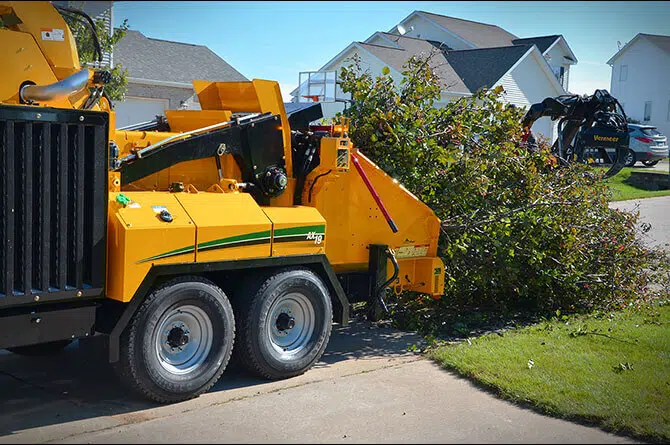
Conclusion
Ok, so let’s do a quick recap. In this article we’ve covered where buckthorn came from, what it looks like, how it spreads, and why it’s a problem. We looked at seven ways to effectively remove buckthorn, when to treat it, how to apply herbicide or use plastic bags, and three ways to deal with brush piles. Hopefully by this point, you’ve found a solution to your buckthorn problem. Now is the time to apply what you’ve learned by tackling your buckthorn removal project. It’s gonna be a big undertaking, but at least you’ve equipped yourself with a game plan by reading this blogpost.
Bonus: Buckthorn Removal Cost
But what if you don’t have the time to do this yourself? What if you’d rather hire a buckthorn removal company to take care of it for you? Well, if that’s your plan, then the next step is to look at your budget and get a customized estimate from a professional landscape company. The overall cost for buckthorn removal really depends on the job requirements. It’ll cost more if the buckthorn has grown to mature trees with a trunk larger than 4 inches in diameter. In that case, a chainsaw will be required for tree removal. It won’t cost as much if you don’t need the brush hauled away. In other words, the price will go down if you have a place on your property where the buckthorn can be piled up. Some buckthorn removal companies charge by the hour and rates range from $40 – $60 per hour per person. Click here to get a free buckthorn removal quote from His Workmanship or click here to learn more about our process.



